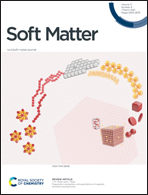Phase transition characterization of poly(oligo(ethylene glycol)methyl ether methacrylate) brushes using the quartz crystal microbalance with dissipation†
Abstract
Heterogeneous non-linear poly(ethylene glycol) analogs, like poly(oligo(ethylene glycol)methyl ether methacrylate) (POEGMA), are of particular interest in the fabrication of smart biocompatible coatings as they undergo a reversible macromolecular rearrangement in response to external heat stimuli. The phase transition dynamics of POEGMA coatings in response to external temperature stimuli have been poorly investigated. The quartz crystal microbalance with dissipation (QCM-D) can be used to investigate the phase transition of these functional coatings as polymer brushes in a dynamic and noninvasive in situ measurement. POEGMA brushes with different thickness are synthesized from the surface of a QCM-D sensor following a living radical polymerization technique by varying the monomer molecular weight. Investigations on the thermoresponsive collapse and swelling of POEGMA brushes grafted from the surface of a QCM-D sensor reveal the reversible phase transition nature of these coatings. Furthermore, the potential of these smart coatings in the field of biotechnology was explored by investigating the absorption and desorption of a model drug. A pulsatile drug release profile triggered by an increase in temperature is observed from POEGMA brushes. POEGMA brushes have the potential to be utilized as polymer coatings for controlled and programable drug release.



 Please wait while we load your content...
Please wait while we load your content...